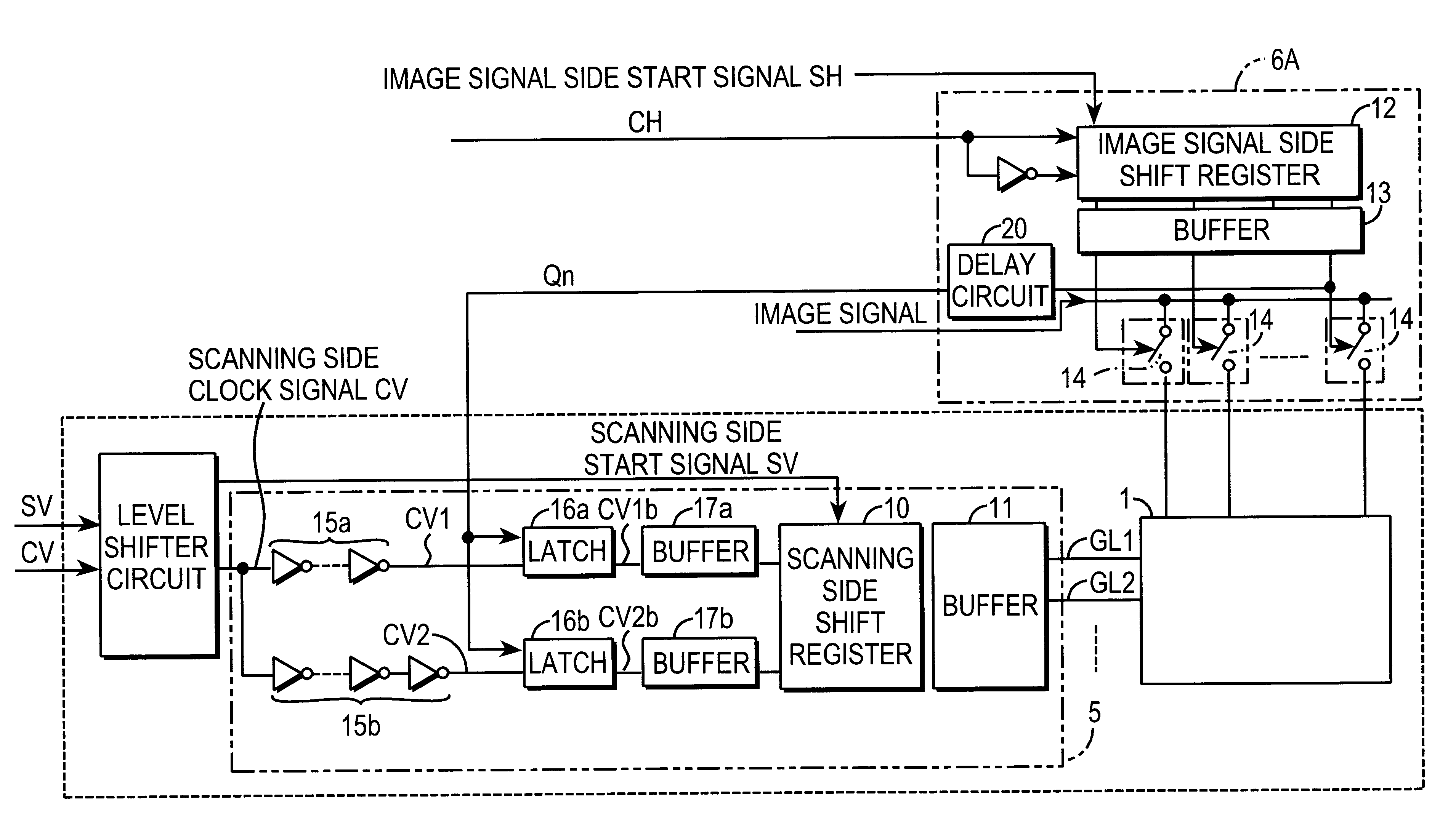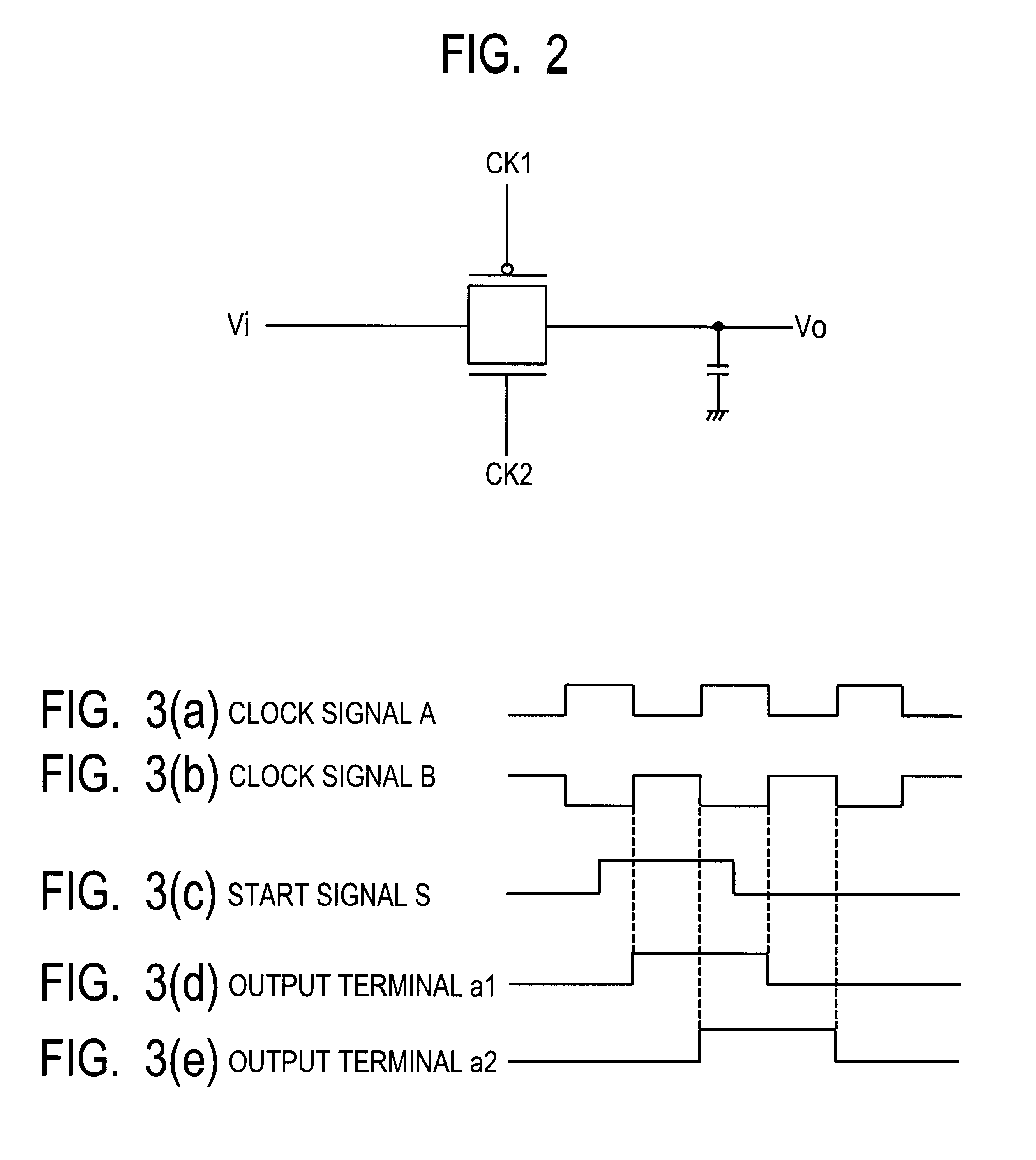Motion circuit and on-board driver circuit for liquid crystal display panel employing the motion circuit
a technology of motion circuit and driver circuit, which is applied in the direction of static storage, digital storage, instruments, etc., can solve the problems of driver circuit malfunction, driver circuit failure, and poor performance of polycrystalline silicon in the speed of transmitting clock signals to the driver circuit, so as to reduce the occurrence of failure phenomenon and ensure stable circuit operation without malfunction
- Summary
- Abstract
- Description
- Claims
- Application Information
AI Technical Summary
Benefits of technology
Problems solved by technology
Method used
Image
Examples
embodiment 2
FIG. 9 is a diagram showing the entire structure of the driver circuit of Embodiment 2, and FIGS. 10(a)-10(f) are the timing charts of the driver circuit. In the present embodiment, the scanning side driver circuit 5 is a circuit internal to a liquid crystal display panel, but an image signal side driver circuit 6A, which is composed of single crystalline silicon, is an external circuit. The image signal side driver circuit 6A is external because it must be composed of single crystalline silicon transistors to meet the demands for high transistor performance when a liquid crystal display panel has a large screen. Consequently, in the present embodiment, the image signal side clock signal has a much shorter period than that in Embodiment 1, so that the skew period of a normal phase and reverse phase scanning side clock signals CV1 and CV2 becomes longer than that of the image signal side clock signal CH. This makes it impossible to use the image signal side clock signal CH as a latch...
embodiment 3
FIG. 13 is a diagram showing the structure of the main part of the driver circuit of Embodiment 3. The feature of the driver circuit of Embodiment 3 is that the normal phase and reverse phase clock signals CK1 and CK2 having no clock skew are generated from the single phase clock signal CK by using two inverter chain circuits. FIG. 13 shows a first inverter chain circuit 21, a second inverter chain circuit 22, and a shift register 23. The first and second inverter chain circuits 21 and 22 have different number of connected inverters from each other by one, so that their outputs are logical reverse to each other. The first inverter chain circuit 21 will enter the single phase clock signal CK and supply the normal phase clock signal CK1 to the shift register 23. The second inverter chain circuit 22 will enter the single phase clock signal CK and supply the reverse phase clock signal CK2 to the shift register 23.
The first and second inverter chain circuits 21 and 22 are structured as f...
embodiment 4
FIG. 15 is a diagram showing the structure of the main part of the driver circuit of Embodiment 4. The diagram shows an inverter 31, a delay circuit 32 having the same delay time as the inverter 31 and not performing logical reverse at its input / output terminals, buffers 33 and 34, and a shift register 35. The delay circuit 32 can be composed of a transfer gate or internal resistance (resistance of semiconductor layers composed of ion-doped polycrystalline silicon). In the structure, a reverse phase clock signal CK4, which is the reverse of a single phase clock CK, becomes the output of the inverter 31. A normal phase clock signal CK3 having the same phase as the single phase clock CK, on the other hand, becomes the output of the delay circuit 32. Since the delay circuit 32 has the same length of delay time as the inverter 31, there is no clock skew between the reverse phase clock signal CK4 and the normal phase clock signal CK3. As a result, the shift register 35 is supplied with t...
PUM
| Property | Measurement | Unit |
|---|---|---|
| time | aaaaa | aaaaa |
| threshold voltage | aaaaa | aaaaa |
| threshold voltage | aaaaa | aaaaa |
Abstract
Description
Claims
Application Information
 Login to View More
Login to View More - R&D
- Intellectual Property
- Life Sciences
- Materials
- Tech Scout
- Unparalleled Data Quality
- Higher Quality Content
- 60% Fewer Hallucinations
Browse by: Latest US Patents, China's latest patents, Technical Efficacy Thesaurus, Application Domain, Technology Topic, Popular Technical Reports.
© 2025 PatSnap. All rights reserved.Legal|Privacy policy|Modern Slavery Act Transparency Statement|Sitemap|About US| Contact US: help@patsnap.com



